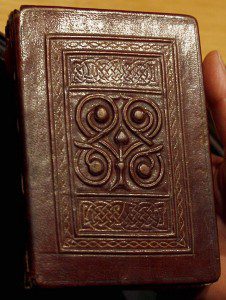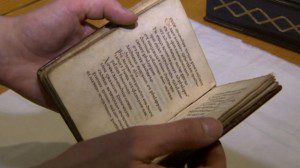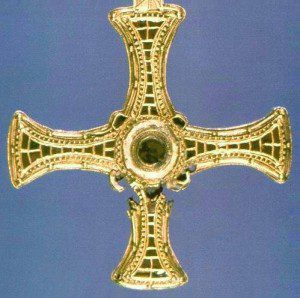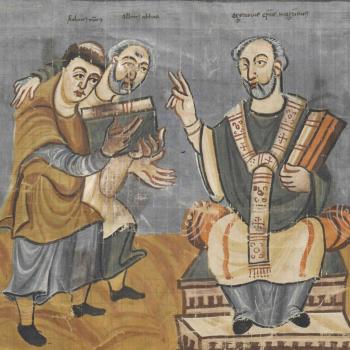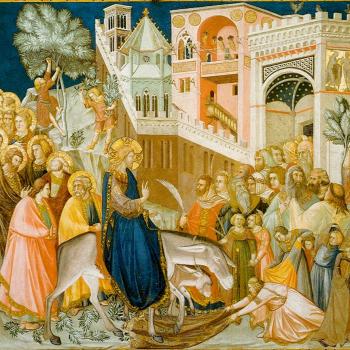Whenever I teach Christian history, I feel a strong obligation to discuss the methodology of approaching early texts, to understand how they are put together. The best single resource I have ever found for this purpose is Bishop Stephen Neill’s Interpretation of the New Testament 1861-1961, which was subsequently revised and expanded by N. T. Wright in 1986. When you have read this book, you have acquired an excellent grasp of how scholars read ancient manuscripts. You understand how (for instance) they decide that one reading rather than another is likely to be authentic, and the stages by which incorrect or extraneous materials creep into the text. Take this as an unqualified recommendation for Neill and Wright! (Note to Tom Wright: isn’t it time for another update? An awful lot has happened since 1986).
Neill’s work was in my mind last year when I was doing some work on the great early English saint Cuthbert. Although Cuthbert died in 687, he was in the news because of a treasure that was buried in his tomb, a copy of the Gospel of John that is the oldest intact European book. In 2012, it sold for $14 million.
In other ways too, Cuthbert marks some spectacular firsts. Around the year 700, a monk on the remote northern English island of Lindisfarne sat down to write a Life of the recently departed saint, which is the very first known literary work written by an English author. So venerated was Cuthbert that just a few years afterwards, he was the subject of a second biography, by the brilliant English scholar Bede, writing just sixty miles away from Lindisfarne.
And this is where I come back to Stephen Neill and the reading of ancient texts. When I was an undergraduate many centuries ago, I read both these Lives for a tutorial, and I was delighted to make an independent discovery about how stories grow over time. (My supervisor was the legendary Anglo-Saxon scholar, Peter Hunter Blair).
How did Cuthbert die? We know for certain that he resorted to a hermitage on the barren Farne islands, best known today as the haunt of seals and seabirds, where he died. Bede’s account of the death is famous. The account of Cuthbert’s final sufferings runs for several pages, and ends with an elaborate speech including “a few strong admonitions respecting peace and humility.” The dying saint particularly warns against “those who err from the unity of the Catholic faith, either by keeping Easter at an improper time, or by their perverse life.” This was all highly relevant to the religious and political conflicts of the time.
That’s what Bede thought about the death around the year 725. It is interesting then to turn back to the earlier Lindisfarne Life, according to which Cuthbert spent most of his final days alone, pausing only to heal a monk called Walhstod who came over from Lindisfarne to attend to him. After taking communion, “[Cuthbert] lifted up his eyes and hands to heaven, he commended his soul to the Lord and, sitting there, he breathed his last, and without a sigh [sine gemitu] went in the way of his fathers.” He died “without a sigh” – or without delivering any of the lengthy and political addresses we read in Bede.
Now, there are two obvious choices here. Either the Lindisfarne Life knew all about the improving words in the deathbed speeches, but modestly decided to omit them; or else, Cuthbert actually died quietly, and Bede or his sources decided to invent what that the great saint should have said, had he but thought to do so. Obviously, Option B is vastly more likely, if only because no biographer could conceivably have failed to include those great speeches if he had access to them. The fact that the author lived in the Lindisfarne community means that he would certainly have known the stories if they had been circulating at that early date.
Bede was a superb historian, who would never have dreamed of inventing material, but he was only as good as his sources. In this instance, we know exactly where he was getting his Cuthbert material. As he says, “I will describe his death in the words of him who related it to me, namely, his attendant priest Herefrid, a most religious man, who also at that time presided over the monastery of Lindisfarne, in the capacity of abbot.”
My conclusion, then, was simple. Cuthbert died quietly. At some point between 700 and 720 or so, Abbot Herefrid invented the speeches Cuthbert should have given, stressing themes that seemed appropriate to the church of his own day. He then passed the material on to Bede, who had no reason to doubt it, given the excellent source – Herefrid was the abbot of Cuthbert’s own monastic house, for heaven’s sake.
Really, though, there is no alternative to concluding that the account of the saint’s death is fictitious, and that, unusually for the Middle Ages, we actually can name the person who invented the legend. That detracts not an iota from Cuthbert’s achievements or reputation, but it does suggest how stories grow over time.
By the way, that finding also raises a red flag over any other piece of information attributed to Herefrid.
Putting that together single-handed back so many years ago was one of the great educational breakthroughs of my college years. I like to think it also gave me a suitably critical attitude to any and all other historical sources!


